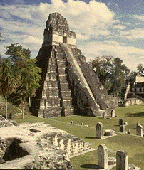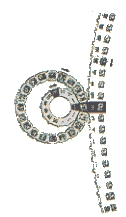Calendar and Prophecies

The Maya kept time with a combination of several cycles that meshed together to mark the movement of the sun, moon and Venus. Mayan calendar of rituals, known as the Tzolkin, was composed of 260 days. This Mayan calendar pairs the numbers from 1 through 13 with a sequence of the 20 day-names shown below. It works something like our days of the week pairing with the numbers of the month. Thus you might have 1-Imix (similar to Sunday the 1st) followed by 2-Ik (just as you would have Monday the 2nd). When you get to 13-Ben, the next day would start the numbers over again, thus 1-Ix, 2-Men etc. It will take 260 days before the cycle gets back to 1-Imix again (13 x 20).
The symbols shown below represent the 20 day-names and are identified with their Yucatec names, pronunciation and approximate translation. The name, meaning and symbol can vary in different Maya languages. Also, each day can be represented with more elaborate glyphs known as “Head Variants” – a formal writing system which can be loosely compared to our script alphabet versus our print alphabet.




IMIX
ee mesh
waterlily, world IK’
eek’
wind AK’BAL
ok bol
night-house K’AN
k’ on
maize




CHIKCHAN
cheek chon
snake KIMI
kee me
death MANIK’
ma neek’
hand LAMAT
la mot
Venus




MULUK’
mul ok’
water OK
ak
dog CHUEN
chew in
monkey EB
eb
tooth




BEN
ben
reed IX
eesh
jaguar MEN
men
eagle KIB
keeb
soul




KABAN
kah bon
earth ETZ’NAB
ehts’ nob
flint, knife KAWAK
kah wok
storm AHAW
ah how
Lord
The Classic Mayan civilization was unique and left us a way to incorporate higher dimensional knowledge of time and creation by leaving us the Tzolkin calendar. Mayan calendars we use today. The present calendar ends in the year 2012.
By tracking the movements of the Moon, Venus, and other heavenly bodies, the Mayans realized that there were cycles in the Cosmos. From this came their reckoning of time, and a calendar that accurately measures the solar year to within minutes.
The “Calendar Round” is like two gears that inter-mesh, one smaller than the other. One of the ‘gears’ is called the tzolkin, or Sacred Round. The other is the haab, or Calendar Round.

The Tzolkin consisted of 13 months each 20 days long, and the Haab of 18 months each 20 days long, and five rest days, thus making 365 days. The date was written using both rounds. For example, “6 lk 10 Camber” might be the same as if we wrote “20 June 30 Gemini.” (Haab – Calendar round / 20 June, and Tzolkin – Sacred round / 30 Gemini.) As both thesewheels turned so passed the Mayan calendar years. Every 52 years the cycle began again. It was on one of these auspicious years that Cortez landed, thus giving credence to his god image.
Archeologists – claim that the Maya began counting time as of August 31, 3114 B.C. This is called the zero year and is likened to January 1, AD. All dates in the Long Count begin there, so the date of the beginning of this time cycle is written 13-0-0-0-0. That means 13 cycles of 400 years will have passed before the next cycle begins, which is December 27, 2012. The new cycle will begin as 1-0-0-0-0.
A day was called a “kin”, and still is today. A 20 day month was a “uinal”, one solar year was a “tun”, 20 tuns a “katun”, and 20 katuns were a “baktun”, 13 of which take us back to the August 13, 3114 B.C. date.
Another notable date is 9-9-2-4-8 or July 29, 615 AD when the great King of Palenque, Lord Pakal ascended to the throne.
These dates are carved in stone throughout the Mayan territory, and the numbers can be seen by anyone. Using a vestigial system (they counted all the fingers and toes) and only three characters (we use ten) the Maya could string together very large numbers, these were read from the bottom up. So Pakal ascended on 9-9-2-4-8, that would read:
9 baktuns – 3600 years
9 katuns – 180 years
2 tuns – 730 days
4 uinals – 80 days
8 kin – 8 days
These numbers, if we begin at August 13, 3114 BC, will give us a date in the 7th century that corresponds to the date Pakal took the throne in Palenque.
The Maya also understood the concept of zero, and wrote it like a shell.
With the new century almost upon us time takes on more meaning. January 1, 2000 would be written 12-19-6-1-0 in the Long Count.